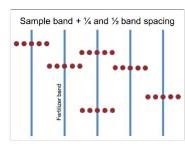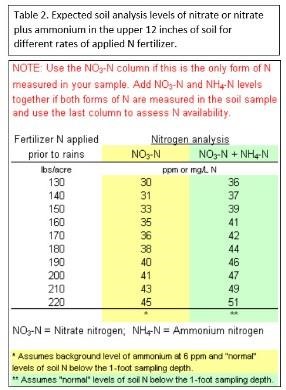The two primary loss mechanisms are leaching N below the soil root zone and denitrification with heavy rain and flooding. Leaching occurs with the nitrate form of N and is more typical on coarse-textured or sandy soils. Fine-textured soils with poor drainage where ponding occurs are where denitrification is most likely. Bacteria in the ground will use the oxygen from the nitrate molecule resulting in nitrogen gas. N gas formed is lost to the atmosphere. Bacteria will begin the denitrification process within two to three days of soil saturation (Lee et al., 2007).
Impact of N form applied
Nitrogen in the nitrate form is subject to leaching or denitrification losses. However, our fertilizer sources are a mix of nitrate and ammonium. The conversion of ammonium to nitrate requires time and the time needed depends upon soil temperatures and the use of a nitrification inhibitor. Using a nitrification inhibitor (e.g., nitrapyrin) can help delay the conversion of fertilizer nitrogen into the nitrate form. A nitrification inhibitor can potentially delay the conversion of ammonium to nitrate by 2 to 6 weeks, depending on environmental conditions (Omonode and Vyn, 2013; Havlin et al., 2014). However, this conversion delay is likely closer to 2 weeks at this point in the growing season due to warmer soil temperatures. A urease inhibitor can delay the conversion of urea to nitrate by 7 to 10 days.
Table 1. Approximate time until fertilizer nitrogen is in the nitrate form (Havlin et al., 1999)
Fertilizer Source | Approximate Time Until Ammonium | Approximate Time Until Nitrate |
Ammonium sulfate, 10-34-0, MAP, DAP | 0 weeks | 1 to 2 weeks |
Anhydrous ammonia | | 3 to 8 weeks |
Urea | 2 to 4 days | 1.25 to 2.5 weeks |
UAN | 50% from urea in 2 to 4 days
25% is ammonium, 0 weeks | 50% in 1.25 to 2.5 weeks
25% in 1 to 2 weeks
25% is nitrate, 0 weeks |
Estimating Denitrification Losses
Soil temperature and how long soil is saturated also influence the amount of nitrate lost from denitrification. At soil temperatures between 55 to 65 degrees Fahrenheit, approximately 2 to 3% of soil nitrate is lost per day under saturated conditions. If the soil temperature exceeds 65 degrees Fahrenheit, around 4 to 5% of the soil nitrate is lost daily. Also, remember it takes approximately 1 to 2 days for saturated soil to reach anaerobic conditions.
Let’s think through an example where we made a side-dress application of 28% UAN at 150 lbs N/acre three weeks ago. Table 1 suggests that 100% of the UAN is now in nitrate form. If saturated soil conditions exist for 6 days with soil temperatures greater than 65 degrees, we expected a 20% loss [5% per day X 4 days (subtracted 2 days for the lag time until a saturated soil reaches anaerobic conditions)] of the 150 lbs N/acre was denitrified or lost (approximately 30 lbs N/acre). These calculations are strictly estimates and may not reflect actual N losses since so many factors interact in nitrate conversion and loss from the soil. An additional consideration is that corn submerged or ponded for 3 to 4 days may experience significant root damage, limiting supplemental nitrogen application benefits.
Estimating Leaching Losses
Determining the amount of N loss from leaching, like denitrification, also depends on the amount of nitrogen fertilizer applied in the nitrate form (Laboski, 2016) (Table 1).
Using an example of 150 lbs of N/acre of UAN containing a nitrification inhibitor applied 1 week ago in a side-dress application, only 25% of the UAN is likely in the nitrate form. Therefore, approximately 37.5 lbs N/acre has the potential to be leached with heavy rainfall. Keep in mind the crop has also taken up some nitrogen since application, so the potential N leaching loss is less than 37.5 lbs N/acre. Furthermore, nitrogen leaching is also dependent on soil drainage patterns and the total amount of water required for soil to reach field capacity (White, 2018). More significant nitrogen leaching loss is likely to occur on coarse-textured, sandier soil types than on fine-textured, loam, and clay soil types. Established rooting depth is also necessary to estimate potential nitrogen loss from leaching. Just because nitrogen has moved downward in the soil profile doesn’t mean the nitrogen has moved out of the root zone. This is especially true in seasons where dry conditions occur early and rooting depth increases.
With delayed planting and side-dressing in 2022, considering the timing of nitrogen applications compared to when flooded conditions existed in your fields is important to answer the question of if any supplemental N is needed?
Can a Pre-Sidedress Nitrogen test provide a better answer?
Taking the time to soil test, which gives a number to develop a recommendation, is an option for quantifying soil available N. For many years, the Pre-sidedress Nitrogen Test (PSNT) has been a valuable tool in making nitrogen recommendations in manured fields. Camberato and Nielsen, 2017 shared their thoughts on using a PSNT test to assess soil N availability from previous fertilizer applications.

The PSNT sampling method is to take 12-inch deep cores from representative areas of the field. Where fertilizer N was broadcast-applied rather than banded, collect 20 to 30 random soil cores per sample. If fertilizer N was banded rather than broadcast-applied, collect 15 to 20 groups of 5 soil cores each that proportionally represent areas with and without banded fertilizer. Take one core in the center of the band, then two cores on both sides of the center at a quarter and half of the band spacing.
The lab results showing either a nitrate (ppm) or nitrate plus ammonium (ppm) can be compared to expected N levels shown in Table 2. The recommendation is If the corn is healthy and the growing season is expected to be typical from here on out, they suggest applying no more than 10 pounds of N for every 2 ppm reduction in soil sample N below the expected levels listed in Table 2.

Recognize that as a healthy crop moves through the rapid growth phase before pollination, soil N levels will naturally decrease in response to rapid N uptake by the plants. However, by the time a healthy crop reaches the V9 leaf stage (about 30 inches tall), only 19 lbs/ac N (equivalent to 5 ppm soil NO3-N in a 1-foot deep sample) have typically been taken up by the plants (Mengel, 1995). But, by the time a healthy crop reaches shoulder-high (~V15 or 60 inches tall), approximately 116 lbs/ac N (equivalent to 29 ppm soil NO3-N in a 1-foot deep sample) have been taken up by the plants. With later corn, the amount of N in the plant should be considered when evaluating soil N.
Source : osu.edu